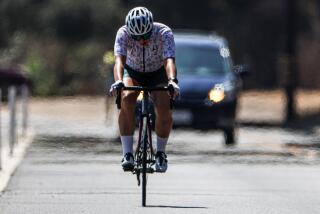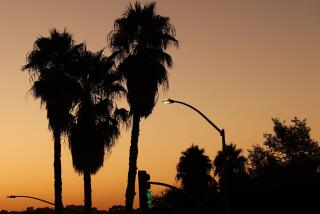L.A. County’s emergency system weathers the heat
As the mercury shot upward Monday, first responders and power utilities braced for a hellish day of outages, heat-related illnesses and brush fires.
But if they expected chaos, they got a manageable onslaught instead.
Put to an aggressive test, Los Angeles County’s emergency system handled strains during the short but intense heat wave, responding to a swell in heat-related medical calls and record energy demand with relative precision, even as temperatures pushed to an all-time high of 113 degrees in downtown Los Angeles.
Dispatchers at the Emergency Operations Center, four floors beneath Los Angeles City Hall East, hunkered down to answer an incessant influx of emergency calls from morning to midnight, a volume of calls that was among the heaviest on record — larger even than during the 1994 Northridge earthquake, officials said.
“We couldn’t keep up with the calls that were coming in,” said Los Angeles Fire Department Capt. Gail Manning, a floor supervisor. The incidents “were spiking all day long. The dispatchers were really taking a beating. They went from one call to another.”
Although fire officials logged 1,900 calls and rushed 697 people to local hospitals for treatment, there was little to no jump in heat-related patient admissions to county hospitals, according to a spokesman for the Los Angeles County Department of Health Services.
Still, at least two deaths have been attributed to the heat since Monday, according to the Los Angeles County coroner’s office.
Arquimedes Jose Mestre, 56, was found dead of hyperthermia Monday on a street in Pomona. The coroner’s office also determined that the death of 56-year-old Sally Menke, the longtime film editor for director Quentin Tarantino, who was discovered dead early Tuesday morning in Griffith Park, was heat-related.
About 100,000 power customers faced outages throughout Southern California as crews worked to repair cables, circuit breakers and transformers that conked out in the heat.
Overall, however, the complications were less severe than in past heat waves. In July 2006, day after day of sweltering heat claimed more than 100 lives statewide and unrelenting power demand led to outages that darkened more than 1 million households in Southern California.
Firefighters and utility operators said the 2006 heat wave served as a wake-up call and that they were simply more prepared this time around.
“It’s pretty much a given: Anytime you have extreme weather, you’re going to get extreme calls because people are not used to it,” said Capt. Sam Padilla of the Los Angeles County Fire Department, where emergency calls went up about 20% Monday because of an increase in heat-related medical problems. Calls to the Orange County Fire Authority jumped 40%.
The National Weather Service also credited a unique weather pattern that was more spike than wave, bringing an intense but quick shot of dry heat to the Los Angeles Basin that peaked Monday afternoon but quickly receded, cooling by about 10 degrees in most places by Tuesday.
The first heat-related emergency call crackled across the Los Angeles Fire Department radio shortly after 1 p.m. Monday. It was a man in his 60s who had passed out at the side of an auto parts store at 109th and Figueroa streets.
It was one of 22 calls Monday that were classified as heat exposure, said Los Angeles Fire Department Battalion Chief Mike Rhodes.
But it could have been worse.
On Monday, the air was so dry that although many communities broiled in temperatures exceeding 110 degrees, the humidity was not high enough to trigger the combination of heat and moisture that results in the most serious heat-related illnesses, according to the National Weather Service.
The power grid seemed to weather the heat remarkably well, even as utilities broke usage records. The Los Angeles Department of Water and Power recorded its highest-ever demand for electricity at 3:45 p.m. Monday, surpassing the previous record set on July 24, 2006.
The heat did not cause more widespread outages partly because electrical systems are better at accommodating quick spikes in temperature and power demand than during periods of sustained heat, officials said.
The numbers seem to reflect that. About 100 electric transformers have failed and 81,000 customers have lost power since Sunday, compared to the 2006 heat wave, when outages touched 1.1 million customers and 1,300 transformers had to be replaced, Southern California Edison Co. officials said.
“The system in general is more robust,” said Henry Martinez, grid operations director for Southern California Edison.
Adding to the complications: By midafternoon, a fire that broke out near transmission lines in Shasta forced grid operators to shut down a major power-importing artery in Northern California and ask utilities to activate their voluntary energy cutback programs.
In Southern California, that meant that all 341,000 Southern California Edison customers who have volunteered to have their air conditioners automatically turned off to decrease demand were called upon.
More to Read
Sign up for Essential California
The most important California stories and recommendations in your inbox every morning.
You may occasionally receive promotional content from the Los Angeles Times.











